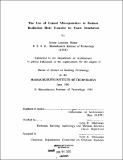| dc.contributor.advisor | Leon R. Glicksman. | en_US |
| dc.contributor.author | Marge, Arlene Lanciani | en_US |
| dc.date.accessioned | 2005-09-06T20:22:16Z | |
| dc.date.available | 2005-09-06T20:22:16Z | |
| dc.date.copyright | 1991 | en_US |
| dc.date.issued | 1991 | en_US |
| dc.identifier.uri | http://hdl.handle.net/1721.1/26827 | |
| dc.description | Thesis (M.S.)--Massachusetts Institute of Technology, Dept. of Architecture, 1991. | en_US |
| dc.description | Includes bibliographical references (leaves 126-129). | en_US |
| dc.description.abstract | Polyurethane foam is the most effective insulation currently available for buildings. Chlorofluorocarbon (CFC) blowing agents, which have low thermal conductivities, contribute highly to the effectiveness of this insulation. However, CFC blowing agents are being phased out because they are depleting the earth's protective ozone layer. Alternate blowing agents, with higher thermal conductivities, will compromise the insulating value of the foam insulation. To counteract this effect, the author has sought to improve the effectiveness of foam insulation by increasing its extinction coefficient. In this work, theoretical analysis and experimental measurements have been used to study and increase the extinction coefficient of polyurethane foam insulation. Radiative heat transfer, which accounts for approximately 25% of the total heat transfer through foams, is inversely proportionate to the extinction coefficient. Foam cell walls presently have a transmissivity of about 80% to infrared radiation. The extinction coefficient of foams can be improved by decreasing the cell sizes or by increasing the absorptivity of the foam cell walls. The approach of this work has been to increase the cell wall opacity through the addition of opaque micropowders. Conduction through the solid polymer is of the same magnitude as the radiative transfer, also accounting for approximately 25% of the heat transfer of the foam. To maintain the low thermal conductivity of the polymer, the micropowders added to reduce radiative transfer through the foam must not change its characteristic conductivity. Polymer micropowders with thermally opaque coatings of graphite have been developed in this work using core micropowders with diameters between 8 and 30 [mu]m. Theory predicts that the smaller the particle size, the larger the resulting improvement in extinction coefficient. The coatings required for opacity are less than 0.1 [mu]m thick, composing less than 7% of the overall volume of the powder. The extinction coefficients of the coated micropowders have been experimentally derived and agree well with analytical predictions. These coated micropowders have been added to foams with the goal of increasing their extinction coefficients. The resulting foams indeed demonstrate improved extinction coefficients when compared to a powderless control foam. This improvement results both from reduction in cell size and increased cell wall opacity. The resulting effective conductivities of the foams have been decreased by as much as 6% through the addition of these relatively large micropowders. These results correlate well with predicted values and indicate that the addition of smaller particles will result in even more improvement. | en_US |
| dc.description.statementofresponsibility | by Arlene Lanciani Marge. | en_US |
| dc.format.extent | 234 leaves | en_US |
| dc.format.extent | 9677684 bytes | |
| dc.format.extent | 9708414 bytes | |
| dc.format.mimetype | application/pdf | |
| dc.format.mimetype | application/pdf | |
| dc.language.iso | en_US | |
| dc.publisher | Massachusetts Institute of Technology | en_US |
| dc.rights | M.I.T. theses are protected by copyright. They may be viewed from this source for any purpose, but reproduction or distribution in any format is prohibited without written permission. See provided URL for inquiries about permission. | en_US |
| dc.rights.uri | http://dspace.mit.edu/handle/1721.1/7582 | |
| dc.subject | Architecture | en_US |
| dc.title | The use of coated micropowders to reduce radiation heat transfer in foam insulation | en_US |
| dc.type | Thesis | en_US |
| dc.description.degree | M.S. | en_US |
| dc.contributor.department | Massachusetts Institute of Technology. Department of Architecture | |
| dc.identifier.oclc | 24882071 | en_US |
